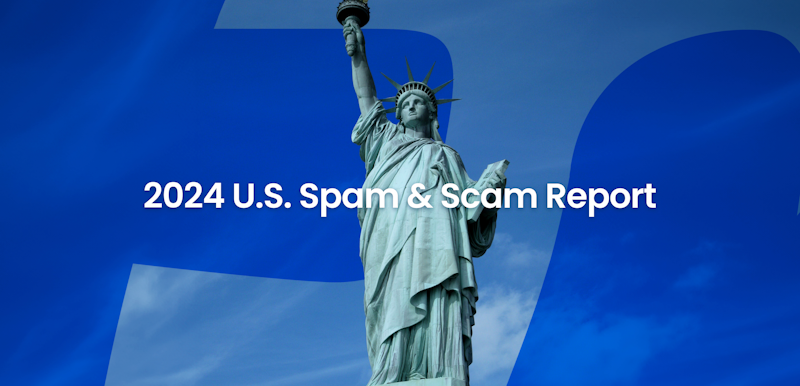
Truecaller Insights 2021 U.S. Spam & Scam Report
Truecaller
Jun 28, 20217 min readEdited on Sep 17, 2021
It’s time for the 7th edition of the Truecaller Insights US Spam & Scam Report. Phone scams are relentless and the numbers don’t lie. A staggering 29.8 Billion USD* was lost to phone scams in America over the past 12 months. Please read on for further findings.
Here are the key findings from the 2021 report:
- As many as 59.49M Americans (23%) report having lost money as a result of phone scams in the past 12 months – up from 56 million (22%) in 2020.
- 1 in 3 Americans (31%) report having ever fallen victim to phone scams, and 19% on more than one occasion.
- Of those who lost money to phone scams in the past 12 months:
- The money lost to scam calls in the past 12 months equates to an estimated 9.8 billion USD*.
- 59% of Americans have received scam calls and/or SMS in the past year.
- The average reported loss was 02 – up from 51 in 2020.
- Robocallers duped 60% of these people.
59.4 million Americans have fallen victim to a phone scam in the past 12 months
In the past 12 months, over 59.49 million Americans lost money to phone scams. This is a clear increase compared to last year’s 56 million and 43 million from 2019. Once again, this is the highest number recorded since we started researching scam and spam calls in the US 7 years ago.
Losses to phone scams totalled 9.8 billion USD in the past 12 months
Over the past seven years, the total money lost to scam calls in the US has been growing significantly. In just the past 12 months, an estimated 9.8 billion USD* was lost to phone scams, which is a 49.7% increase compared to last year’s 9.7 billion USD.
The average reported loss to scam calls has increased 43% in the past 12 months
Among those affected by scam calls, the average money lost was 02 USD. This is a 43% increase compared to last year (51 USD).
The graph above shows the trend over the past seven years. While there was a downward trend in 2015 and 2019, the past 12 months have recorded the highest ever average amount of money lost to phone scams.
Scams from robocalls remain a big problem in the U.S. despite a small overall reduction in numbers
While there was a small reduction in the number of victims who lost money to a robocall scam in the past 12 months, it continues to be a big problem. 3 in 5 Americans (60.0%) have admitted to losing money as the direct result of a robocall. Just a friendly reminder here, according to the Federal Trade Commission (FTC) , any robocall trying to sell you something is illegal. The only exception is if the caller has written permission, directly from you, to call you in this way. The FTC also state that even if you have given such permission to a company in the past, you always retain the right to revoke that permission at any time.
Nearly 3 out of 5 Americans have received scam calls or SMS related to COVID-19 in the past 12 months
Since the pandemic first hit, scammers have been taking advantage of the situation with scam calls related to COVID-19. This is very much a global problem too. In an indication that the pandemic is perhaps far from over, we found that 59% of Americans have received scam calls or text messages related to COVID-19 in the past 12 months, up from 44% the previous year. As you know, some countries fare better than others when it comes to overall case numbers, percentage of population vaccination and positivity rates. However, the pandemic will only well and truly be over when every country is able to vaccinate at similar rates. We expect the trend of COVID-19 related scam calls to increase next year as well.
Men get scammed more than women
In the past 12 months, among those who have been a victim of a phone scam, 59.4% of those were men and 38.3% were women. The rest (2.3%) of those who participated identify as non-binary or preferred not to reveal their gender.
Similar to previous years, younger men and women between the ages of 18-44 years are more susceptible to phone scams
Younger men are more likely than older men to fall victim and lose money to a phone scam, particularly men aged 18-34 (40%) and age 35-44 (46%), compared to men aged 45 and older (28%). Among women, the age groups that are most susceptible are also 18-34 years olds (31%) and 35-44 year olds (25%).
Mobile phones continue to be the preferred medium
Scam calls over mobile phone have increased from 49% in 2014 to 85% in 2021. Meanwhile, phone scams over landlines have decreased from 36% to 20%.
Downloading a spam blocker/caller ID app continues to be the predominant action after being scammed
When scammed, 44% of people downloaded a spam blocker and/or caller ID app. This was slightly lower compared to 47% in the previous year. 31% took the inconvenient step of cancelling their credit card/changing account numbers. Another 31% took the trouble of reporting the scam to the authorities, up from 28% in the previous year.
On average, Americans received nearly 31 spam calls per user per month, up from 28 calls in the previous year
This year, we saw that Americans received (mobile and/or landline) in an average month. Of these, 21.5 were robocalls.
Nearly 3 in 5 Americans (59%) reported receiving more spam calls (on a mobile or landline) and/or text messages now than they did a year ago. 14% said they received fewer.
Nearly said they try to only answer calls if they can identify the person or business calling. This clearly highlights the need for an efficient and accurate caller ID service.
The average number of spam texts per month is 16.9, continuing significant year on year increases (14.7 in 2020, 10.6 in 2019 and 8.5 in 2018).
If they received a call from an unknown number, 67% of Americans would completely ignore it. If they received a text from an unknown number, 65% of Americans said they would delete it.
Here is a link to the full 2021 US Scam and Spam Report:
https://drive.google.com/drive/folders/13cVi1wX2umtw20OVaxf2vtVmX-OZHDxC?usp=sharing
For all the images in the Report, download from this link:
https://drive.google.com/drive/folders/1mXSP-EhwUVTtf8nVdHrPdUGpiqBu_svH?usp=sharing
Survey Methodology:
The phone scam survey was conducted online within the United States by The Harris Poll on behalf of Truecaller from March 16-18, 2021. 2,045 U.S. adults aged 18 and older participated. The phone spam survey was conducted online within the United States by The Harris Poll on behalf of Truecaller from March 18-22, 2021. 2,002 U.S. adults ages 18 and older participated. These online surveys are not based on a probability sample and therefore no estimate of theoretical sampling error can be calculated.
For complete survey methodology, including weighted variables and subgroup sample sizes, please contact press@truecaller.com.
Earlier surveys referenced – conducted online by The Harris Poll on behalf of Truecaller:
2020 phone scam survey – March 20-24, 2020, among 2,024 U.S. adults
2020 phone spam survey – March 19-20, 2020, among 2,050 U.S. adults
2019 phone scam survey – March 19-21, 2019 among 2,030 U.S. adults
2019 phone spam survey – March 21-25, 2019 among 2,040 U.S. adults
2018 phone scam survey – March 13-15, 2018 among 2,036 U.S. adults
2018 phone spam survey – March 22-26, 2018 among 2,049 U.S. adults
2015 phone spam survey – November 17-19, 2015 among 2,104 U.S. adults
2014 phone scam survey – July 18-22, 2014 among 2,040 U.S. adults
*2020 International Data Base US Census Population Estimates showed a U.S. adult population (ages 18 and older) of 258,672,483. Based on 23 percent of U.S. adults reporting losing money in a phone scam, the total number of phone scam victims in the U.S. is estimated to be 59,494,671. The average phone scam victim in the survey reported losing 02. This equates to a total of 9.8 billion.
You can find earlier reports here: https://truecaller.blog/category/truecaller-insights/
About Truecaller:
People use Truecaller to stay ahead. It helps them know who’s getting in touch, filter out unwanted calls and SMS, and focus on what really matters. The mobile apps offer Caller ID, an intelligent dialer, spam blocking, messaging and more. Truecaller’s mission is to build trust everywhere by making communication smarter, safer and efficient. Headquartered in Stockholm, Sweden, the company was founded in 2009 by Alan Mamedi and Nami Zarringhalam. Investors include Sequoia Capital, Atomico and Kleiner Perkins.
About The Harris Poll:
The Harris Poll is one of the longest running surveys in the U.S. tracking public opinion, motivations and social sentiment since 1963. It is now part of Harris Insights & Analytics, a global consulting and market research firm. We strive to reveal the authentic values of modern society to inspire leaders to create a better tomorrow. We work with clients in three primary areas; building a twenty-first-century corporate reputation, crafting brand strategy and performance tracking, and earning organic media through public relations research. Our mission is to provide insights and advisory to help leaders make the best decisions possible. Learn more at www.theharrispoll.com
Head to Truecaller’s Youtube Channel, Instagram, Facebook and Twitter to keep up to date with new and improved features for Truecaller.

Truecaller
Jun 28, 20217 min read


